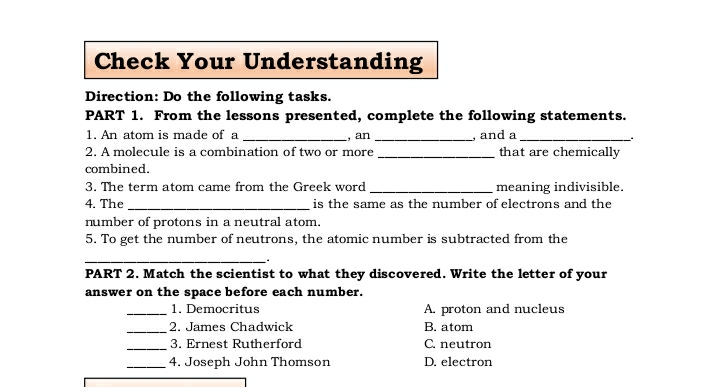Check Your Understanding Direction: Do the following tasks. PART 1. From the lessons presented, complete the following statements. 1. An atom is made of a 2. A molecule is a combination of two or more , and a that are chemically an combined. 3. The term atom came from the Greek word 4. The meaning indivisible. is the same as the number of electrons and the number of protons in a neutral atom. 5. To get the number of neutrons, the atomic number is subtracted from the PART 2. Match the scientist to what they discovered. Write the letter of your answer on the space before each number. 1. Democritus A. proton and nucleus 2. James Chadwick B. atom 3. Ernest Rutherford C. neutron 4. Joseph John Thomson D. electron
Check Your Understanding Direction: Do the following tasks. PART 1. From the lessons presented, complete the following statements. 1. An atom is made of a 2. A molecule is a combination of two or more , and a that are chemically an combined. 3. The term atom came from the Greek word 4. The meaning indivisible. is the same as the number of electrons and the number of protons in a neutral atom. 5. To get the number of neutrons, the atomic number is subtracted from the PART 2. Match the scientist to what they discovered. Write the letter of your answer on the space before each number. 1. Democritus A. proton and nucleus 2. James Chadwick B. atom 3. Ernest Rutherford C. neutron 4. Joseph John Thomson D. electron
Introductory Chemistry: A Foundation
9th Edition
ISBN:9781337399425
Author:Steven S. Zumdahl, Donald J. DeCoste
Publisher:Steven S. Zumdahl, Donald J. DeCoste
Chapter5: Nomenclature
Section: Chapter Questions
Problem 11CR: What are bus? How are ions formed from atoms? Do isolated atoms form ions spontaneously? To what do...
Related questions
Question
100%
answer all

Transcribed Image Text:Check Your Understanding
Direction: Do the following tasks.
PART 1. From the lessons presented, complete the following statements.
1. An atom is made of a
, and a
that are chemically
an
2. A molecule is a combination of two or more
combined.
meaning indivisible.
is the same as the number of electrons and the
3. The term atom came from the Greek word.
4. The
number of protons in a neutral atom.
5. To get the number of neutrons, the atomic number is subtracted from the
PART 2. Match the scientist to what they discovered. Write the letter of your
answer on the space before each number.
1. Democritus
A. proton and nucleus
2. James Chadwick
B. atom
3. Ernest Rutherford
C. neutron
4. Joseph John Thomson
D. electron
Expert Solution
This question has been solved!
Explore an expertly crafted, step-by-step solution for a thorough understanding of key concepts.
Step by step
Solved in 2 steps

Knowledge Booster
Learn more about
Need a deep-dive on the concept behind this application? Look no further. Learn more about this topic, chemistry and related others by exploring similar questions and additional content below.Recommended textbooks for you

Introductory Chemistry: A Foundation
Chemistry
ISBN:
9781337399425
Author:
Steven S. Zumdahl, Donald J. DeCoste
Publisher:
Cengage Learning

Chemical Principles in the Laboratory
Chemistry
ISBN:
9781305264434
Author:
Emil Slowinski, Wayne C. Wolsey, Robert Rossi
Publisher:
Brooks Cole


Introductory Chemistry: A Foundation
Chemistry
ISBN:
9781337399425
Author:
Steven S. Zumdahl, Donald J. DeCoste
Publisher:
Cengage Learning

Chemical Principles in the Laboratory
Chemistry
ISBN:
9781305264434
Author:
Emil Slowinski, Wayne C. Wolsey, Robert Rossi
Publisher:
Brooks Cole


Living By Chemistry: First Edition Textbook
Chemistry
ISBN:
9781559539418
Author:
Angelica Stacy
Publisher:
MAC HIGHER